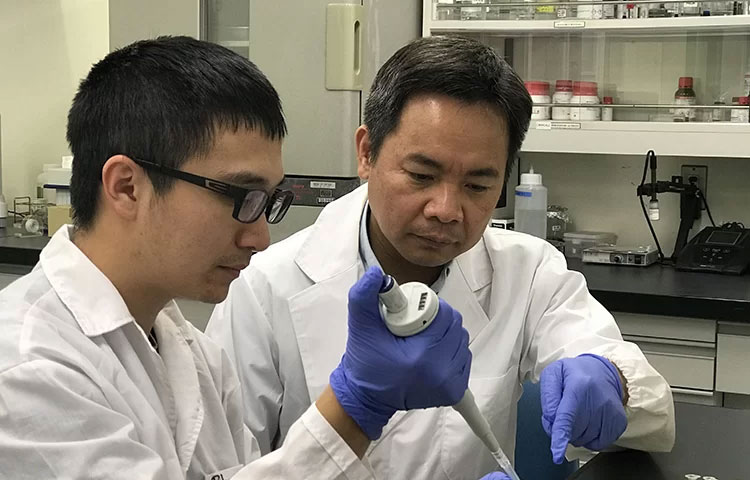Detection of fungal herbicides 6 times stronger than Glyphosate
Cordycepin found in Cordyceps fungus can replace the popular Glyphosate type in Vietnam banned list from April 10, 2019.
The research team led by Associate Professor Tran Dang Xuan, Head of the Laboratory of Plant Physiology and Biochemistry, Hiroshima University (Japan) has just released the discovery of Cordycepin isolated from Cordyceps militaris Cordyceps fungus There are new outstanding herbicidal properties, in MDPI's international journal Molecules on August 9, 2019. This finding helps to research and create potential herbicides. This is a new finding because Cordycepin was previously known only as a compound that inhibits cancer, diabetes and other human diseases.

Associate Professor Tran Dang Xuan (right) and colleagues at the laboratory.(Photo: Tran Ngoc Quy).
After successful separation by column chromatography, the scientists assessed the potential for cell toxicity of Cordycepin for Raphanus sativus (radish). The results showed that the rate of germination and growth of Cordycepin was 3.8-5.9 times higher than that of benzoic acid (one of the compounds used as Herbicide). Cordycepin reduces the content of chlorophyll and carotene, accelerating the process of electrolyte leakage in radish plants. The study results showed that Cordycepin was the main plant growth inhibitor isolated from Cordyceps militaris fungus , which had superior herbicide ability.
In the market, there are currently no types of herbicide products from natural compounds that are more effective than chemical herbicides. Most chemical herbicides are mostly harmful to the environment, especially groundwater. Therefore, this Cordycepin promises to contribute to research and development of herbicides that can control weeds or unwanted plants without harming useful, environmentally friendly crops. , to serve agricultural production.
In medicine, Cordyceps militaris ( C. militaris ) is an Ascomycetes fungus. In nature, C. militaris is found only in herbal remedies. This fungus contains medicinal properties including anti-stress, fatigue, oxidation and inhibition of cancer cells. The fruit body of C. militaris contains many active ingredients such as cordycepin, adenosine, polysaccharides, fatty acids, amino acids and other chemical components. Among them, cordycepin and adenoisine have superior biological and pharmacological functions such as antioxidant, anti-inflammatory, inhibiting cancer cells.

Cordyceps fungus.
Scientists in the group are now investigating the potential for herbicides and superiority to Cordycepin's current herbicides, specifically clarifying why this compound is safe for humans, possibly. The ability to inhibit cancer, diabetes . but has higher activity than Glyphosate herbicide up to 6 times.
Associate Professor Tran Dang Xuan and German Prof. Rolf Teschke and his research team believe that Cordycepin will be the basis for scientists around the world to develop many new herbicides with high safety for humans as well as environment. The research results were submitted to Hiroshima University for registration of international copyright as well as in Japan.
The fact that chemical herbicides are being used in the market not only poses many risks to agricultural production but also greatly affects the surrounding environment. Recently, the Plant Protection Department has issued a list of banned herbicides containing Glyphosate on the market from April 10, 2019. This is a pesticide compound widely used in the world as well as in Vietnam, but is warned by WHO as a cause of group 2A cancer for blood, lung, and prostate cancer from years. 2015.
- Sex-killing herbicides of male frogs
- Herbicides alter global ecosystems
- No one expected the tow truck with flamethrowers to be an effective weed exclusion tool
- The fusion furnace has a magnetic field 100,000 times stronger
- Exposure to pesticides is prone to Parkinson's disease
- How dangerous is herbicide poisoning Paraquat?
- The bulletproof jacket is 10 times stronger than steel from fish mucus
- American doctors are concerned about a new deadly fungal infection strain
- Herbicides cause open stomach disease in the fetus
- How does Agent Orange destroy the environment in Vietnam?
- The method of killing weeds does not use chemicals
- Detection of coffee protein has a stronger effect than morphine
 'Barefoot engineer' invents a pipeless pump
'Barefoot engineer' invents a pipeless pump Process of handling dead pigs due to disease
Process of handling dead pigs due to disease Radiometer
Radiometer Warp Engine: Technology brings us closer to the speed of light
Warp Engine: Technology brings us closer to the speed of light